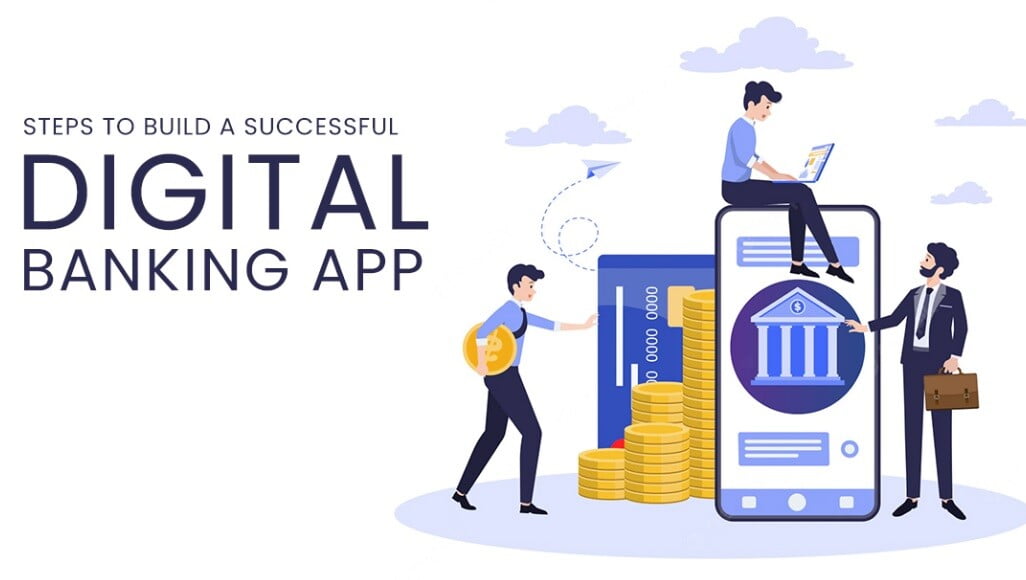The global mobile banking market is expected to reach $1.3 billion by 2028. When mobile apps became popular, the financial services industry was not immune. During this time period, a need arose for the creation of FinTech applications.
Customers’ lives have been simplified by the convenience of mobile banking apps, which allow for instantaneous financial transfers, bill payments, account statements, and more. Banks are investing in digital banking app development since there are several advantages to offering mobile banking to their consumers. In this blog, we will take a look at the steps you need to take in order to build a robust digital banking app.
Steps to develop a digital banking app
Decide what you want to include
Before making the first move toward making the digital app, it’s important to start with a clear plan. The mobile app strategy will help businesses figure out how the product will fit into the ecosystem of the bank, interact with customers, and bring in money.
By doing market research, you can find out the pain points and needs of your target customers, as well as the things that other banking apps don’t do well. This step is probably the most important since if you don’t do it, you’ll waste time making an app that doesn’t meet the customers’ main needs.
Security first
Security should be your first concern when you decide to build a digital banking app. Because the banking app has sensitive information in it, it has become a juicy target for cybercriminals. So, you should think about the necessary cybersecurity measures as soon as you start planning. Before development begins, there are a few things that can be done to improve security.
Before being stored in a database, all passwords must be encrypted. Also, the “Forget password” function needs to be built on strong validation tools so that lost login credentials can be recovered and app users can safely change their login credentials.
When a user hasn’t used an app for a certain amount of time, they should be automatically logged out of the system on both the front end and the back end.
The process of verifying a user’s identity should be safe and easy for them to use. Biometrics and two-factor authentication (2FA) need to be built into the logic of your banking app, along with commonly used authentication steps like one-time passwords (OTP), message confirmation, or encrypted PINs.
The developers of the banking app should only be able to see tokens, passwords, and other sensitive information from a limited number of users. Instead, all customer information will be stored on platforms that are safe.
Zero in the UX & UI of the banking app
Since an easy-to-use user interface (UI) is one of the most important parts of a great banking app, this step should be given a lot of attention. You should pay more attention to the following best practices:
- The layout, colors, icons, buttons, and forms of the mobile app should all follow the brand guidelines for your bank.
- The navigation should give a high-level look at the way the app is put together.
- A simple menu structure that lets users do everything they need to do from one page.
- The app should work well on both Apple’s iOS and Google’s Android.
- The feature that shows the account balance should be easy to find for the users of the banking application.
Technology Stack and the Development Team
Choosing the right technology stack for fintech app development is important because it can help you save time and make your app more secure. On your list of things to check for the tech stack, you should include the following:
- Scope and difficulty of the project
- The number and nature of professionals required
- Tools and software needed
- Documents and specifications
Also, you will need the right development team to make sure that the plan for the app can be turned into reality. If the development process is complicated and needs a lot of technical experts, you might want to consider hiring a banking app development team that knows a lot about new software, apps, and technology to help your business grow. While choosing the technology stack, always incorporate the latest fintech trends in your digital banking app to make it more relevant and popular.
Third-party Integrations
Your app will have to integrate with a number of different financial services if you want to give your customers a better experience and incorporate the latest fintech features in your banking app. So, you should carefully plan any APIs that you need to make this happen. With this API, third-party applications can get data from large financial institutions in a safe way. Also, API integrations can be switched out easily without making a lot of changes to your app’s code.
Build and Test the banking app
The development team will need to establish architecture, generate life-like user journeys, and create user-friendly interfaces based on the technological stack and third-party integrations that were selected in the stage before this one.
In addition, because the banking app is a frequent target for cybercriminals, financial institutions need to be on alert for potential security risks at all times. Testing mobile banking apps is required in order to assist you in enhancing core KPIs, optimizing in-app experiences, and experimenting with enhancements that are already in production. When testing the application, it is necessary to take the following into consideration:
- Functionality
- The user interface
- Performance
- Security
Release the digital banking application in app stores
To release your native mobile app, you have to send it to the right app store. For iOS apps, that’s the Apple App Store, and for Android apps, it’s Google Play. Before you can launch your mobile app, you will need a developer account with both the Apple App Store and the Google Play Store.
When you send your app to the app store, use a different name and bundle identifier than the ones you used for QA. This will help you keep QA versions of your app separate from production versions. So, you can keep testing new versions of your app before putting them on the market.
Before putting an app on the app store, you need to prepare metadata, which includes:
- The name of your app
- Short description: What it is, what it is for, and what it is.
- Launch icon
- Images from the App Store
- Promotional video with a banner image
- Category and Keywords
If your app requires users to sign in, you will need to provide a test user account as part of the submission process. Once apps are sent to the app store, they go through a review process. Depending on how good your app is and how closely it follows the app store’s rules, this could take a few days. If your application is turned down, you will be told why. After fixing the problems, you can resubmit the app and let it go through more reviews until it is approved and added to the app store.
Concentrate on post-release activities
Your app’s success may be gauged by keeping an eye on its usage through mobile analytics systems and recording Key Performance Indicators (KPIs) after it has been released to the app stores. Make it a habit to regularly review user reports of crashes and other problems.
Get the word out and ask your app’s users for their input. Maintaining user interest will need prompt maintenance, including regular updates that fix bugs and add new features.
Conclusion
The creation of mobile banking applications is a current trend. Financial institutions of all sizes and ages are increasingly adopting cutting-edge FinTech technologies, rendering legacy banking models obsolete. When you start to second-guess yourself, your rivals are already picking winners. Beginning the development of a unique mobile banking app is a must if you want to stay ahead of the competition.
You may want to read more,
- Top Reasons Why You Need A Mobile App Development Company
- The Future of Website and Mobile App Development: Trends to Watch







